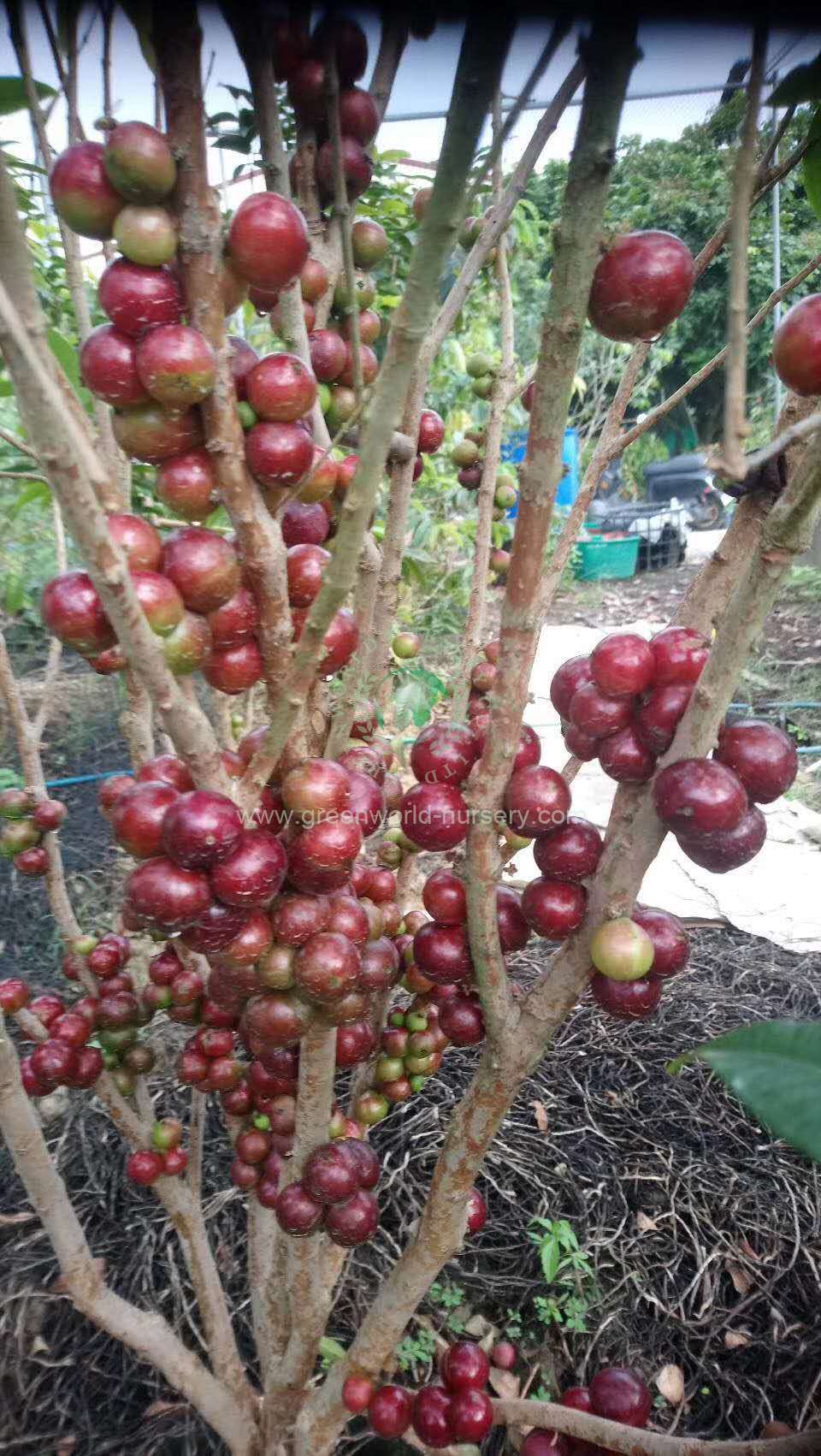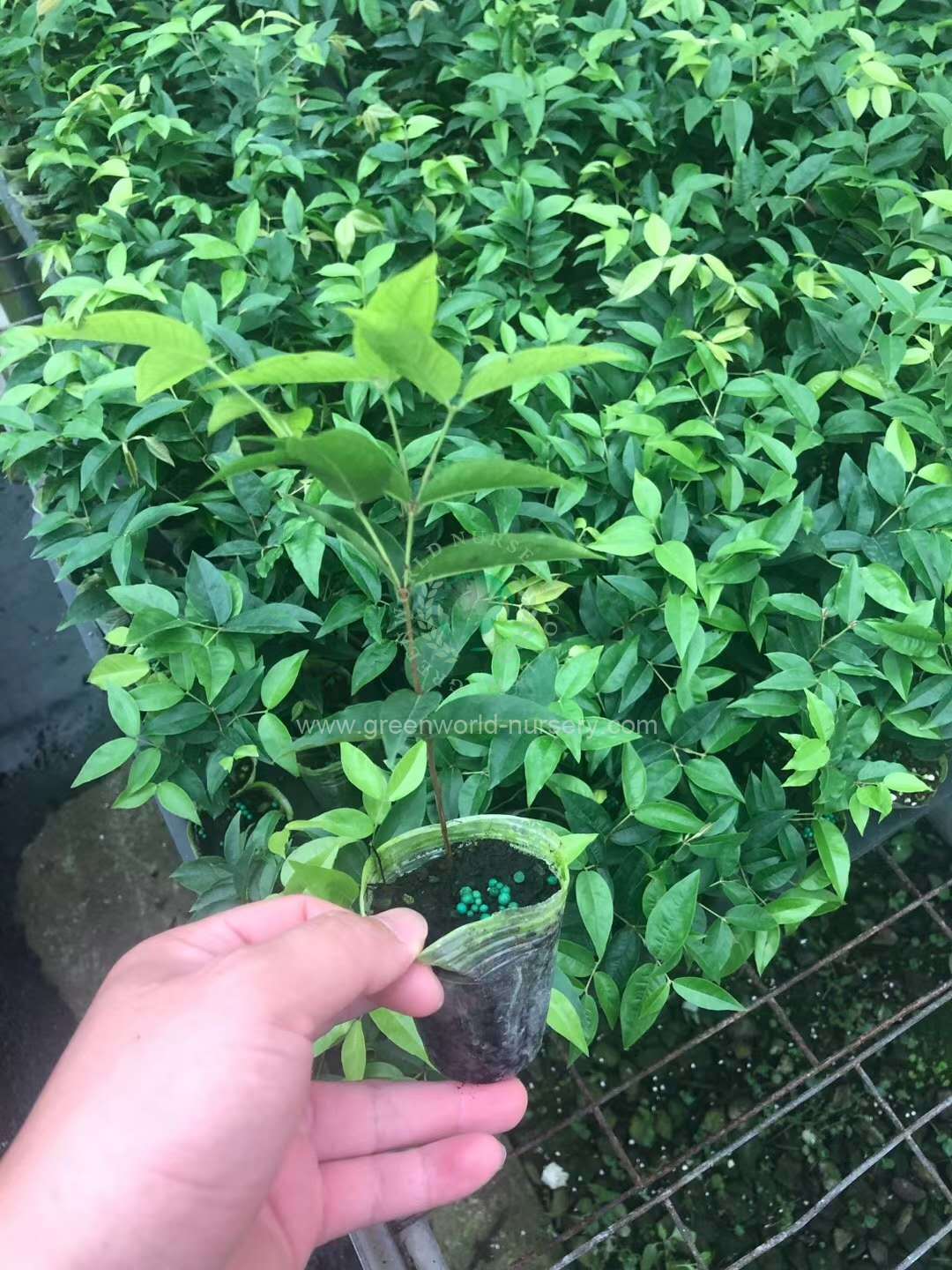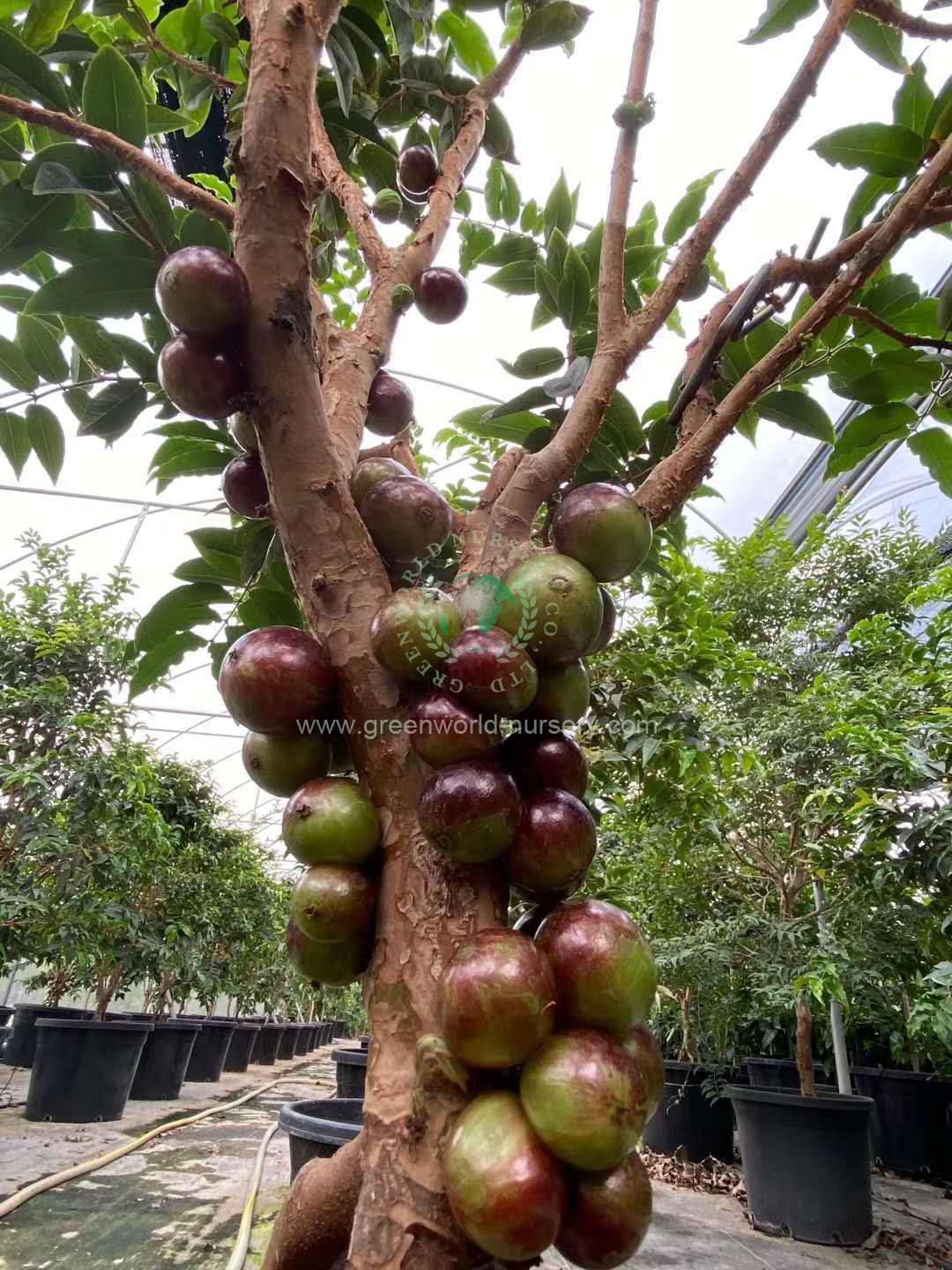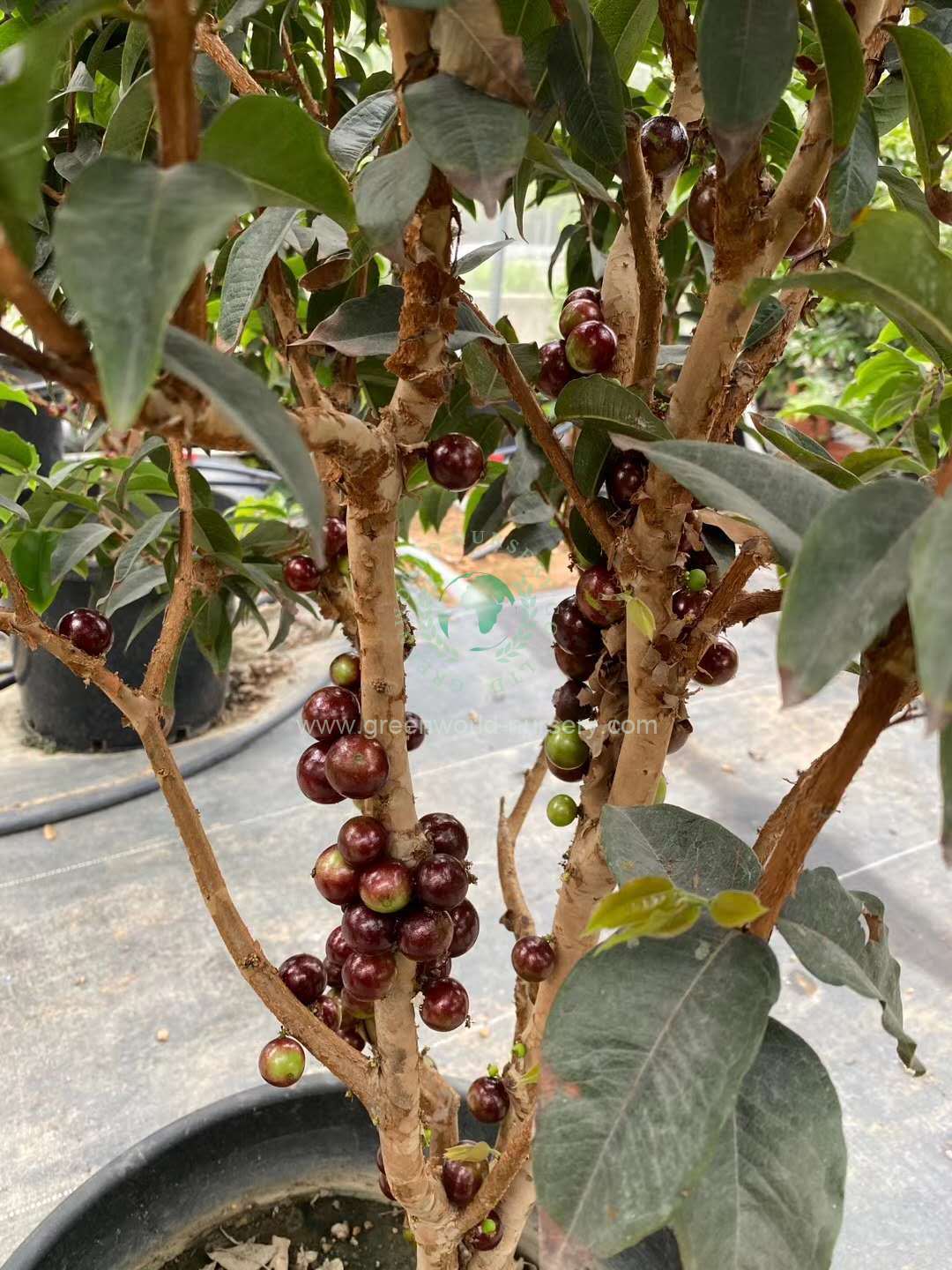





Myrciaria Cauliflora
Categories:
Fruit Trees
Plinia cauliflora, the Brazilian grapetree,[2] jaboticaba or jabuticaba,[2] is a tree in the family Myrtaceae, native to Minas Gerais, Goiás and São Paulo states in Brazil.[2] Related species in the genus Myrciaria, often referred to by the same common names, are native to Brazil, Argentina, Paraguay, Peru and Bolivia.[citation needed] The tree is known for its purplish-black, white-pulped fruits which grow directly on the trunk; they can be eaten raw or be used to make jellies, jams, juice or wine.
E-mail: export@greenworld-nursery.com
Whatsapp: 008613427573540
Keyword:
Myrciaria Cauliflora
Detail
Plinia cauliflora, the Brazilian grapetree,[2] jaboticaba or jabuticaba,[2] is a tree in the family Myrtaceae, native to Minas Gerais, Goiás and São Paulo states in Brazil.[2] Related species in the genus Myrciaria, often referred to by the same common names, are native to Brazil, Argentina, Paraguay, Peru and Bolivia.[citation needed] The tree is known for its purplish-black, white-pulped fruits which grow directly on the trunk; they can be eaten raw or be used to make jellies, jams, juice or wine.
The tree is a slow-growing evergreen that can reach a height of 15 meters if not pruned. The leaves are salmon-pink when young, turning green as they mature.
The tree prefers moist, rich, lightly acidic soil. It is widely adaptable, however, and grows satisfactorily even on alkaline beach-sand type soils, so long as they are tended and irrigated. Its flowers are white and grow directly from its trunk in a cauliflorous habit. In an uncultivated state, the tree may flower and fruit only once or twice a year. When continuously irrigated it flowers frequently, and fresh fruit can be available year-round in tropical regions.
The fruit is a thick-skinned berry and typically measures 3–4 cm in diameter. The fruit resembles that of a slip-skin grape. It has a thick, purple, astringent skin that encases a sweet, white or rosy pink gelatinous flesh. Embedded within the flesh are one to four large seeds, which vary in shape depending on the species.[3]
Common in Brazilian markets, jabuticabas are largely eaten fresh; their popularity has been likened to that of grapes in the United States. Fresh fruit may begin to ferment 3 to 4 days after harvest, so they are often used to make jams, tarts, strong wines, and liqueurs. Due to the short shelf-life, fresh jabuticaba fruit is rare in markets outside areas of cultivation.
In Brazil the fruit of several related species, namely Myrciaria tenella and M. trunciflora, share the same common name. While all jabuticaba species are subtropical and can tolerate mild, brief frosts, some species may be marginally more cold-tolerant
The tree is a slow-growing evergreen that can reach a height of 15 meters if not pruned. The leaves are salmon-pink when young, turning green as they mature.
The tree prefers moist, rich, lightly acidic soil. It is widely adaptable, however, and grows satisfactorily even on alkaline beach-sand type soils, so long as they are tended and irrigated. Its flowers are white and grow directly from its trunk in a cauliflorous habit. In an uncultivated state, the tree may flower and fruit only once or twice a year. When continuously irrigated it flowers frequently, and fresh fruit can be available year-round in tropical regions.
The fruit is a thick-skinned berry and typically measures 3–4 cm in diameter. The fruit resembles that of a slip-skin grape. It has a thick, purple, astringent skin that encases a sweet, white or rosy pink gelatinous flesh. Embedded within the flesh are one to four large seeds, which vary in shape depending on the species.[3]
Common in Brazilian markets, jabuticabas are largely eaten fresh; their popularity has been likened to that of grapes in the United States. Fresh fruit may begin to ferment 3 to 4 days after harvest, so they are often used to make jams, tarts, strong wines, and liqueurs. Due to the short shelf-life, fresh jabuticaba fruit is rare in markets outside areas of cultivation.
In Brazil the fruit of several related species, namely Myrciaria tenella and M. trunciflora, share the same common name. While all jabuticaba species are subtropical and can tolerate mild, brief frosts, some species may be marginally more cold-tolerant
Commercial cultivation of the fruit in the Northern Hemisphere is more restricted by slow growth and the short shelf-life of fruit than by temperature requirements. Grafted plants may bear fruit in five years; seed-grown trees may take 10 to 20 years to bear fruit, though their slow growth and small size when immature make them popular as bonsai or container ornamental plants in temperate regions.
Jabuticabas are fairly adaptable to various kinds of growing conditions, tolerating sand or rich topsoil. They are intolerant of salty soils or salt spray. They are tolerant of mild drought, though fruit production may be reduced, and irrigation will be required in extended or severe droughts.
Previous Page
Next Page
Company Advantages
Quality & Experience
☑ Straight Trunk
☑ Well rooted & Well Formed Canopy
☑ Potted with Cocopeat
☑ More than 15 years Experience for Growing and Exporting Plants
Supply Ability & Plantation
☑ More Than 300000 Potted Plants Per Year
☑ More Than 100 Varieties of Plants Species
☑ More Than 205 Hectares Plantation, Still expanding.
Reasonable Price At All Times
☑ Rational and Competitive Price
☑ Maximum Value Added To Clients
Integrity & Responsibility
☑ Mutual Benefit & Win Win Solution
☑ Responsible For Any Lost Caused By Us

Products Atlas

Myrciaria Cauliflora

Myrciaria Cauliflora

Myrciaria Cauliflora

Myrciaria Cauliflora

Myrciaria Cauliflora

Myrciaria Cauliflora

Myrciaria Cauliflora

Myrciaria Cauliflora

Myrciaria Cauliflora

Myrciaria Cauliflora

Myrciaria Cauliflora

Myrciaria Cauliflora

Myrciaria Cauliflora

Myrciaria Cauliflora

Myrciaria Cauliflora

Myrciaria Cauliflora
Frequently Asked Questions
WHAT IS YOUR QUALITY STANDARD AND AVAILABLE STOCK EACH YEAR?
WHAT IS THE PROCEDURE FOR EXPORTING THE PLANTS?
WHO WILL ARRANGE THE CONTAINER? AND HOW MUCH IS THE TRANSPORT?
WHAT IS YOUR PRICE TERM AND PAYMENT TERM?
WHAT KIND OF DOCUMENTS YOU PROVIDE FOR EXPORTING PLANTS?
WHAT IS THE DELIVERY TIME AFTER PLACING THE ORDER?
ARE YOU A TRADER OR PRODUCER FOR PLANTS?
WILL THE PLANTS DIE IN THE CONTAINER WITHOUT LIGHT AND WATER DURING LONG TRANSPORT?
WHICH SEA PORT WE USE TO EXPORT THE PLANTS?
WHAT KIND OF CONTAINER AND TEMPERATURE FOR EXPORTING THE PLANTS?
PLANTS CATERGORIES
Add:Address:
Gongchun Village, Mingcheng town, Gaoming district, Foshan City, Guangdong province
Phone / Whatsapp / Wechat:
SAF Coolest v1.3.1.2 设置面板 GAGSD-ZGYF-JQXZE-XFW
V1.3.1 SVG图标库请自行添加图标,用div包起来,并命名使用
General Manager : Tom Tse
Phone / WhatsApp / Wechat:
0086-13427573540
Sale: Jenny
Phone / WhatsApp / Wechat:
E-mail:

